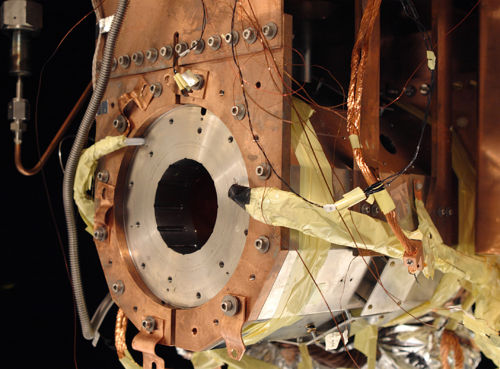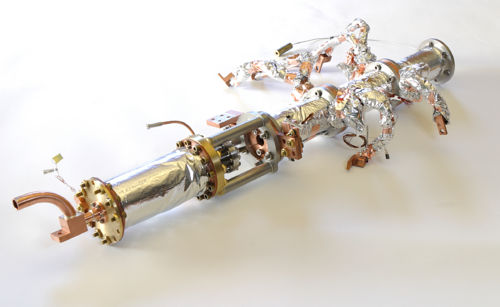Difference between revisions of "NH"
| Line 5: | Line 5: | ||
We cooled nitrogen atoms and NH molecules to 500mK using helium vapor. The species fell into a 4T deep magnetic trap created by two superconducting coils in an anti-Helmholtz configuration. We studied the collisions of the atoms and molecules with helium to elucidate spin relaxation mechanisms. Our results show that the N/NH inelastic collision rate is small enough to cool the NH molecules with N atoms using sympathetic cooling. | We cooled nitrogen atoms and NH molecules to 500mK using helium vapor. The species fell into a 4T deep magnetic trap created by two superconducting coils in an anti-Helmholtz configuration. We studied the collisions of the atoms and molecules with helium to elucidate spin relaxation mechanisms. Our results show that the N/NH inelastic collision rate is small enough to cool the NH molecules with N atoms using sympathetic cooling. | ||
| − | == Sympathetic Cooling of N/NH | + | == Sympathetic Cooling of N/NH == |
For the sympathetic cooling, the background density of helium should be low enough to thermally isolate atoms and molecules from their environment. | For the sympathetic cooling, the background density of helium should be low enough to thermally isolate atoms and molecules from their environment. | ||
In the 1st generation experiments, the helium buffer gas density was set by desorption of helium from a film coating the inside of the trapping cell. | In the 1st generation experiments, the helium buffer gas density was set by desorption of helium from a film coating the inside of the trapping cell. | ||
Revision as of 15:03, 10 November 2010
Contents
N/NH Co-trapping : 1st Generation
We cooled nitrogen atoms and NH molecules to 500mK using helium vapor. The species fell into a 4T deep magnetic trap created by two superconducting coils in an anti-Helmholtz configuration. We studied the collisions of the atoms and molecules with helium to elucidate spin relaxation mechanisms. Our results show that the N/NH inelastic collision rate is small enough to cool the NH molecules with N atoms using sympathetic cooling.
Sympathetic Cooling of N/NH
For the sympathetic cooling, the background density of helium should be low enough to thermally isolate atoms and molecules from their environment. In the 1st generation experiments, the helium buffer gas density was set by desorption of helium from a film coating the inside of the trapping cell. In this experiment, we use dilution refrigerator to ensure low enough helium vapor density.
People
- Yat Shan Au
- Eunmi Chae
- Colin Connolly
- Hsin-I Lu
Recent graduates:
- Wes Campbell (Now as postdoc at Maryland)
- Matt Hummon (Now a postdoc at Boulder)
- Edem Tsikata (Now a postdoc at JPL)
Publications
- Cold N+NH Collisions in a Magnetic Trap. M. Hummon, T. Tscherbul, J. Klos, Hsin-I Lu, E. Tsikata, W. Campbell, A. Dalgarno, J. Doyle. http://arxiv.org/abs/1009.2513
- Collisional properties of cold spin-polarized nitrogen gas: theory, experiment, and prospects as a sympathetic coolant for trapped atoms and molecules T.V. Tscherbul, J. Klos, A. Dalgarno, B. Zygelman, Z. Pavlovic, M.T. Hummon, H. Lu, E. Tsikata, and J.M. Doyle. accepted for publication, Phys. Rev. A (2010)
- Mechanism of Collisional Spin Relaxation in Triplet-Sigma Molecules, W.C. Campbell, T. V. Tscherbul, H.-I Lu, E. Tsikata, R. V. Krems, and J.M. Doyle. Phys Rev Lett 102, 013003 (2009).
- Time-Domain Measurement of Spontaneous Vibrational Decay of Magnetically Trapped NH, W.C. Campbell, G.C. Groenenboom, H. Lu, E. Tsikata, J.M. Doyle. Phys Rev Lett 100, 083003 (2008).
- Magnetic trapping of atomic nitrogen (^14N) and cotrapping of NH (X-triplet-Sigma-), M.T. Hummon, W.C. Campbell, H. Lu, E. Tsikata, Y. Wang, and J.M. Doyle, Phys Rev A 78, 050702(R) (2008).
- Magnetic Trapping and Zeeman Relaxation of NH (X-triplet-Sigma), W.C. Campbell, E. Tsikata, H. Lu, L.D. van Buuren, and J.M. Doyle. Phys Rev Lett 98, 213001 (2007).
- Buffer-gas cooling of NH via the beam loaded buffer-gas method, D. Egorov, W.C. Campbell, B. Friedrich, S.E. Maxwell, E. Tsikata, L.D. van Buuren, J.M. Doyle. Eur
- Buffer-gas cooling of atomic and molecular beams. Dima Egorov, Thierry Lahaye, Wieland Schöllkopf, Bretislav Friedrich, and John M. Doyle. Phys Rev A 66, 043401 (2002)

